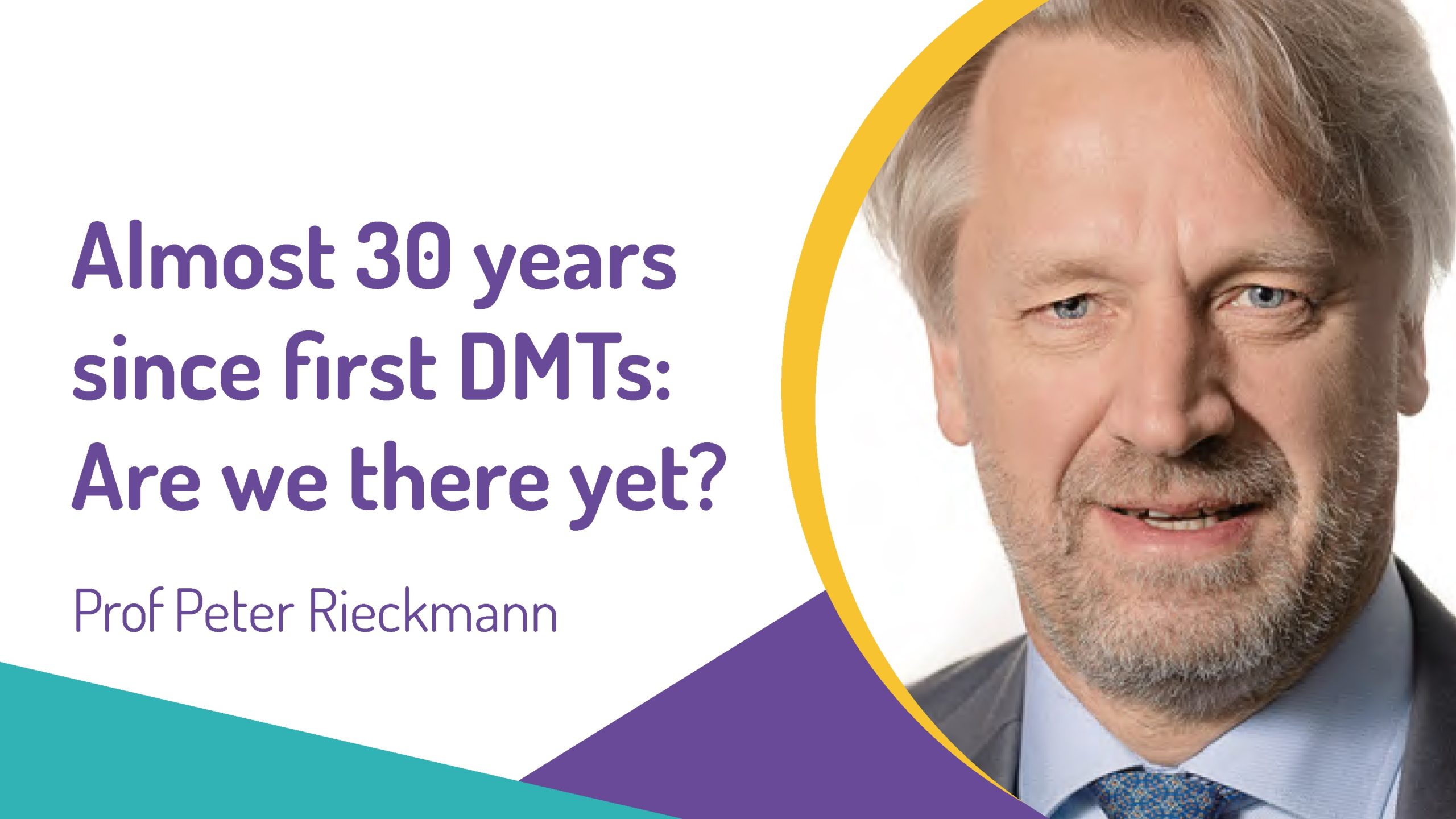
Are We There Yet? Achieving freedom from disease almost 30 years since first disease modifying therapy
Over the past 75 years we have seen more breakthroughs in clinical MS research offering help to our patients than for any other neurological disease. These include improvements in diagnosis, increased understanding of the pathophysiology and types of MS, as well as development of new treatments and better communication tools.1
Having worked in MS care as a neurologist and clinician scientist for the most of my professional career (since 1988) I am grateful now to be able to offer disease modifying treatments that enable many people with MS (PwMS) to live a life in long-term remission, able to focus on their studies, plan for the future and enjoy sports and social activities.
Despite the advances in understanding and treatment of MS, there is still some way to go towards eradicating misdiagnosis of MS, utilizing biomarkers of disease activity, individualizing treatment, potentially even finding a cure.
Our next goal is to move beyond long-term remission, facilitating continuous disease improvement, lower treatment burden and optimizing the side effect profiles of treatment. Based on our current understanding of MS pathophysiology, this can likely be achieved by re-educating the immune system. Some treatments, such as immune reconstitution therapies (IRT), have demonstrated induction of long-term remission combined with low treatment burden (10 or fewer days of active treatment per year). There are cohorts of PwMS receiving some treatments who have experienced no evidence of disease activity (NEDA) for over 10 years.2 This comes close to eradicating the prognosis of further disease progression.2-4 The challenge is to adopt this kind of definite treatment approach at an early stage of disease evolution, when central nervous system integrity can still be saved from autoimmune destruction thereby increasing the prospect of freedom from disease for PwMS, for longer.
Discussion
With the development of improved MS therapies we have witnessed a better informed patient population more actively involved in their treatment decisions. This is due, in part, to initiatives that aim to make MS research more accessible to PwMS, such as PRISMS or MS-Selfie.5,6 We need to ensure PwMS and their support networks have better access to, and understanding of, the critical information and developments central to achieving freedom from disease. This engagement with their care will help to increase the chances they will achieve a higher level of personalized treatment that they can commit to.
Conclusion
To enable people with MS to have even more control over their disease, we will need to:
- Further refine parameters of disease control and time span for long-term remission
- Address cognition more comprehensively to monitor and manage this pervasive and broadly disabling symptom
- Continue to include the patient voice in R&D, including PwMS, caregivers and patient groups, to ensure that treatments being developed are relevant, targeted and appropriate
- Implement digital and patient reported outcomes measurements to more closely reflect the overall relevant disease burden or improvement and lived experience
- Develop criteria for a cure (including clinical and paraclinical markers of disease activity) for MS at any stage of the disease
- Undertake clinical trials to determine whether vaccines or treatments against EBV can prevent or modulate the course of MS7
There is much to celebrate in terms of emerging advanced MRI technologies, potential biomarkers of disease activity and the development of new therapies allowing episodes of long-term remission. We are coming closer to a life without MS, but we are not there, yet. Further research is required to increase our understanding of MS pathophysiology, advance therapies, and enable optimal treatment choices.8-10
References
- National Multiple Sclerosis Society. (2022) Our Story. Available at: https://www.nationalmssociety.org/About-the-Society/Our-Story [Accessed 18 February 2022]
- Lünemann JD, Ruck T, Muraro PA, Bar-Or A, Wiendl H. (2020) Immune reconstitution therapies: concepts for durable remission in multiple sclerosis. Nature Rev Neurol. 16(1):56-62.
- Boffa, G, et al. (2021) Long-term Clinical Outcomes of Hematopoietic Stem Cell Transplantation in Multiple Sclerosis. Neurology 96; e1215-1226.
- Steingo B, et al. (2020) Long-term efficacy and safety of alemtuzumab in patients with RRMS: 12-year follow-up of CAMM223. J. Neurol. 267: 3343-3353.
- Bharadia, T; Boster, A. (2022) PRISMS: the global initiative empowering people with MS. Available at: https://www.neuro-central.com/prisms-the-global-initiative-empowering-people-with-ms/ [Accessed 19 May 2022]
- Giovannoni, G. (2021) MS-Selfie Available at: https://sites.google.com/giovannoni.net/clinicspeak-dmt/home [Accessed 19 May 2022]
- Rogers, S. (2022) NIH launches clinical trial of Epstein Barr virus vaccine. NIH News releases May, 6th 2022. https://www.niaid.nih.gov/news-events/nih-launches-clinical-trial-epstein-barr-virus-vaccine
- Sapko K, Jamroz-Wiśniewska A, Marciniec M, Kulczyński M, Szczepańska-Szerej A, Rejdak K. (2020) ‘Biomarkers in Multiple Sclerosis: a review of diagnostic and prognostic factors’ Neurol Neurochir Pol. 54(3):252-258. doi: 10.5603/PJNNS.a2020.0037.
- Goldschmidt C, McGinley MP. (2021) ‘Advances in the Treatment of Multiple Sclerosis’ Neurol Clin. 39(1):21-33. doi: 10.1016/j.ncl.2020.09.002.
- Ontaneda D, Sati P, Raza P, Kilbane M, Gombos E, Alvarez E, Azevedo C, Calabresi P, Cohen JA, Freeman L, Henry RG, Longbrake EE, Mitra N, Illenberger N, Schindler M, Moreno-Dominguez D, Ramos M, Mowry E, Oh J, Rodrigues P, Chahin S, Kaisey M, Waubant E, Cutter G, Shinohara R, Reich DS, Solomon A, Sicotte NL; North American Imaging in MS Cooperative. (2021) ‘Central vein sign: A diagnostic biomarker in multiple sclerosis (CAVS-MS) study protocol for a prospective multicenter trial’ Neuroimage Clin. 32:102834. doi: 10.1016/j.nicl.2021.102834.